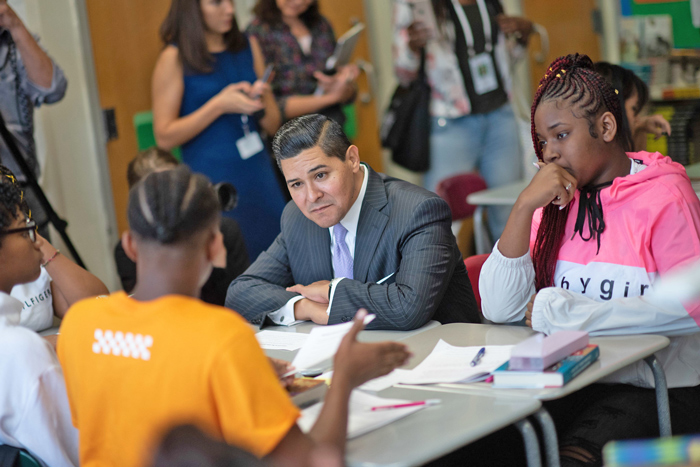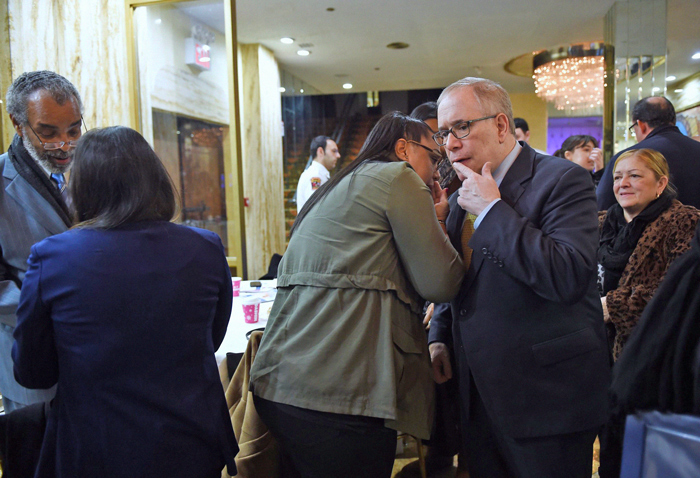Photo Courtesy of Susan Watts/Office of the Comptroller
“As we approach the next academic year, New York City should be leading the nation in figuring out how to safely reopen our schools with a high standard of instruction that maintains academic excellence,” Comptroller Stringer said.
By Michael V. Cusenza
Mayor Bill de Blasio and Schools Chancellor Richard Carranza may have announced their own “Blended Learning” program Wednesday morning, but it was City Comptroller Scott Stringer who beat them to the proverbial punch Tuesday morning with “Strong Schools: A Plan Forward for New York City.”
Stringer outlined the following recommendations for reopening schools safely in the fall:
Require consistent use of masks or face coverings for students and staff
Students in second grade and older should be required to wear a mask or face covering for their nose and mouth. In New York State, all children over the age of two are subject to the Governor’s mandate concerning covering the nose and mouth with a mask when in public and unable to maintain social distance. In a school setting, children in early elementary school – kindergarten and first grades – may be too young to wear masks properly, so face shields could be considered as an appropriate alternate face covering for this age group, as well as for children with medical or other needs that would make wearing a face mask while in the classroom challenging. All adults in the building should also be required to wear masks.
Mandate physical distancing

Photo Courtesy of Michael Appleton/Mayoral Photography Office
City Schools Chancellor Richard Carranza
To maintain proper distance between students requires many schools, particularly overcrowded ones, to stagger schedules and further limit in-classroom instruction for the coming year.
Establish consistent, small cohorts of students to limit the potential spread of COVID-19
When students are grouped in small, consistent cohorts each day, the number of students potentially exposed to someone infected with COVID-19 is lessened. These groups of students remain together throughout the day in the same classroom or other designated area of the building as much as feasible, with teachers, rather than the students, changing locations. The size of cohorts would likely be dependent on the individual capacities in each school building to maintain adequate physical distancing, although given the space constraints of most New York City classrooms it is expected that smaller cohorts of 10-12 students will be the “new normal” for city classrooms.
Provide pooled testing, aggressive contact tracing and daily temperature scans
Universal testing for all NYC students and school staff will be necessary before the start of school.
To continue to test the student body at regular intervals throughout the school year, the DOE could employ pooled testing.
The DOE must establish a transparent protocol for contact tracing within school communities to quickly identify and contain any outbreaks.
Current public health guidance recommends temperature scanning or symptom checking prior to entering any school building
Provide a full-time nurse on staff at every school in the city
The global pandemic revealed the depth of public health need in city schools: as many as 70,000 students attend a school that lacks a school nurse. At a time of acute concern over the health of every child, this is not acceptable, and the DOE must move aggressively to ensure that every school building has a full-time nurse on staff.
Invest in enhanced cleanings and the latest technologies
The CDC has already advised that students remain six feet apart while in school, which will be a serious challenge in many of the city’s most crowded schools. The City should have transparent and stepped-up cleaning protocols for every school building.
Repurpose available spaces and identify outdoor spaces for learning activities
As the City conducts a thorough inventory of classroom, cafeteria and gymnasium space in every school building, there should also be consideration given to repurposing other available spaces outside of school facilities to support classroom needs, including vacated office buildings and underused shared work spaces.
Prioritize social-emotional learning and ensure every school has a full-time social worker and guidance counselor
Many students whose lives and families have been impacted by COVID-19 have experienced serious emotional trauma, particularly those who had significant mental health needs prior to the pandemic disruption.
When schools reopen, it will be critical to ensure that robust mental health services are in place across all schools, and that there is a rich continuum of supports available specifically for students with significant mental health needs.
Such supports should be distinct from mental health consultations or trainings for school staff; rather, schools need access to boots-on-the ground mental health professionals who can provide direct, integrated, trauma-sensitive support to students experiencing emotional or behavioral crises. Specifically, at a minimum every school must have a full-time social worker and guidance counselor on staff.
Make accommodations for high-risk teachers, administrators, and other school staff
Given the proper tools and training, teaching staff working remotely could be assigned to facilitate remote instruction for groups of students or help provide curricular support for families and caregivers. They also could provide remote one-on-one tutoring for students who need additional academic support.
Given the cramped office spaces within most schools, many administrative staffers will need their workspaces configured to ensure proper social distancing can be accomplished. Additionally, the DOE should announce certain HR provisions such as exemptions from sick day limits as well as state and local worker safety regulations.
“The COVID-19 pandemic has taken a huge toll on our students, parents, school staff, and education system. Since the shutdown of our schools back in March, students have had to adjust to the challenges of remote learning — while as parents we tried our best to give our kids the support they need to succeed in these unprecedented circumstances. It’s imperative that the DOE act with urgency to provide a strategic roadmap to reopen city schools,” Stringer added. “As we approach the next academic year, New York City should be leading the nation in figuring out how to safely reopen our schools with a high standard of instruction that maintains academic excellence. If we aren’t smart and prepared for a robust upcoming school year, our students will suffer— especially lower-income students of color who are already facing severe challenges – and our economic recovery will be severely hampered because without school there can be no real return to work for so many of our families. We can’t let down our guard on the quality of our city’s educational system at this moment — and we can’t afford to make mistakes with our children’s futures.”

